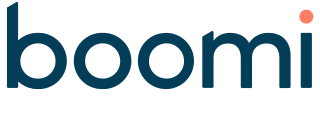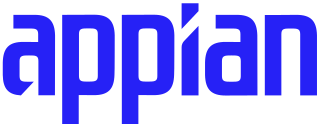Middleware in the context of distributed applications is software that provides services beyond those provided by the operating system to enable the various components of a distributed system to communicate and manage data. Middleware supports and simplifies complex distributed applications. It includes web servers, application servers, messaging and similar tools that support application development and delivery. Middleware is especially integral to modern information technology based on XML, SOAP, Web services, and service-oriented architecture.

Unisys Corporation is an American multinational information technology (IT) services and consulting company founded in 1986 and headquartered in Blue Bell, Pennsylvania. The company provides digital workplace, cloud applications & infrastructure, enterprise computing, business process, AI technology and data analytics services.
Software AG is a German multinational software corporation that develops enterprise software for business process management, integration, and big data analytics. Founded in 1969, the company is headquartered in Darmstadt, Germany, and has offices worldwide.
Software as a service is a software licensing and delivery model in which software is licensed on a subscription basis and is centrally hosted. SaaS is also known as on-demand software, web-based software, or web-hosted software.

Cloud computing is the on-demand availability of computer system resources, especially data storage and computing power, without direct active management by the user. Large clouds often have functions distributed over multiple locations, each of which is a data center. Cloud computing relies on sharing of resources to achieve coherence and typically uses a pay-as-you-go model, which can help in reducing capital expenses but may also lead to unexpected operating expenses for users.
Acumatica provides cloud and browser based enterprise resource planning software for small and medium-sized businesses. The company is headquartered in Kirkland, Washington, in the Seattle metropolitan area.
Adeptia is a Chicago, Illinois based software company. It provides an application to exchange business data with other companies using a self-service integration approach. This business software helps organizations create automated data connections to their customers and partners, and automate pre-processing and post-processing steps such as data validation, exception handling, and back-end data integration.
There are, in essence, three kinds of Cloud printing.
Jelastic is a cloud platform software vendor that provides multi-cloud Platform as a Service-based on container technology for hosting service providers, ISVs, telecommunication companies, enterprises and developers. The platform is available as public cloud in over 70 data centers, as well as virtual and on-premises servers. Jelastic provides support of Java, PHP, Ruby, Node.js, Python, Go environments, custom Docker containers and Kubernetes clusters.
The OpenPOWER Foundation is a collaboration around Power ISA-based products initiated by IBM and announced as the "OpenPOWER Consortium" on August 6, 2013. IBM's focus is to open up technology surrounding their Power Architecture offerings, such as processor specifications, firmware, and software with a liberal license, and will be using a collaborative development model with their partners.
Cloud Elements is a cloud API integration platform that enables developers to publish, integrate, aggregate and manage all of their APIs through a unified platform. Using Cloud Elements, developers can quickly connect entire categories of cloud services using uniform APIs or simply synchronize data between multiple cloud services using its innovative integration toolkit.

Cleo Communications LLC, simply referred to as Cleo, is a privately held software company founded in 1976. The company is best known for its ecosystem integration platform, Cleo Integration Cloud with RADAR.

Dynatrace, Inc. is a global technology company that provides a software observability platform based on artificial intelligence (AI) and automation. Dynatrace technologies are used to monitor, analyze, and optimize application performance, software development and security practices, IT infrastructure, and user experience for businesses and government agencies throughout the world.
"X as a service" is a phrasal template for any business model in which a product use is offered as a subscription-based service rather than as an artifact owned and maintained by the customer. Originating from the software as a service concept that appeared in the 2010s with the advent of cloud computing, the template has expanded to numerous offerings in the field of information technology and beyond it. The term XaaS can mean "anything as a service".

Boomi is a software company that specializes in integration platform as a service (iPaaS), API management, master data management and data preparation. Boomi was founded in Berwyn, Pennsylvania, and first launched its services in 2007.
A headless content management system, or headless CMS, is a back end-only web content management system that acts primarily as a content repository. A headless CMS makes content accessible via an API for display on any device, without a built-in front end or presentation layer.

Appian Corporation is an American cloud computing and enterprise software company headquartered in McLean, Virginia, part of the Dulles Technology Corridor. The company sells a platform as a service (PaaS) for building enterprise software applications. It is focused on low-code development, process mining, business process management, and case management markets in North America, Europe, the Middle East and Southeast Asia.

Netlify is a remote-first cloud computing company that offers a development platform that includes build, deploy, and serverless backend services for web applications and dynamic websites. The platform is built on open web standards, making it possible to integrate build tools, web frameworks, APIs, and various web technologies into a unified developer workflow.
Headless commerce is an e-commerce architecture where the front-end (head) is decoupled from the back-end commerce functionality and can thus be updated or edited without interfering with the back-end, similar to a headless content management system (CMS). The term was coined by Dirk Hoerig, co-founder of Commercetools, in 2013.
Commercetools, stylized as commercetools, is a cloud-based headless commerce platform that provides APIs to power e-commerce sales and similar functions for large businesses. Both the company and platform are called Commercetools. The company is headquartered in Munich, Germany with additional offices in Berlin, Germany; Jena, Germany; Amsterdam, Netherlands; London, England; Durham, North Carolina; Zürich, Switzerland; Sydney, Australia; Shanghai, China and Singapore. Through its investor REWE Group it is associated with the omnichannel order fulfillment software solutions provider fulfillmenttools and the payment transactions provider paymenttools. Its clients include Audi, Bang & Olufsen, Carhartt and Nuts.com. Commercetools is a founding member of the MACH Alliance.







